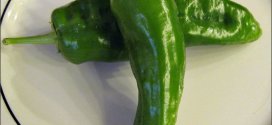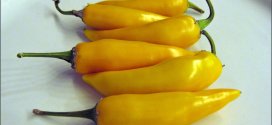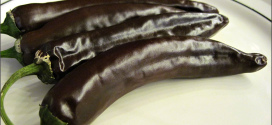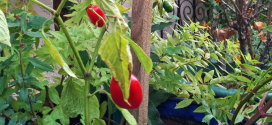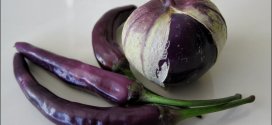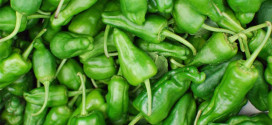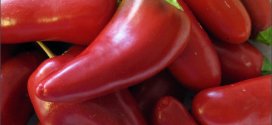The YOLO WONDER bell pepper was developed in Yolo County just west of Sacramento in Northern California. YOLO WONDER – sweet; Bell Elongated Type; 3.5 to 4 inches long by 3 to 3.75 inches wide; thick flesh; matures from dark green to red; pendant pods; green leaves; 24 to 30 inches tall; Mid Season (70-80 days); dependable producer; C.annuum.
Sweet peppers are most easily grown from transplants. Start seed indoors 7 to 10 weeks before the date you intend to set peppers into the garden. Peppers can be seeded in the garden or transplanted out 2 to 3 weeks after the last frost in spring after the soil temperature has risen to at least 65°F. Sweet peppers mature in 60 to 95 days.
Description. Peppers are tender perennials that are grown as annuals. Peppers grow on compact erect bushes 1½ to 2 feet tall. The fruit follows a single flower growing in the angle between the leaf and the stem. Sweet peppers vary in shape and color and include the slender banana pepper; the short, round cherry pepper; the small bright-red, heart-shaped pimiento; the multi-colored Italian frying pepper; and the blocky green to yellow to orange to red bell pepper. Sweet peppers can be eaten raw, cooked, or pickled. Not all sweet pepper varieties are mild flavored; some can be spicy and hot.
Yield. Plant 2 to 3 sweet pepper plants per household member.
Site. Grow peppers in full sun in soil that is rich in organic matter, moisture retentive but well draining. Peppers prefer a soil pH of 5.5 to 6.8. Work aged garden compost into beds prior to planting. The optimal soil temperature for peppers is 65°F or warmer.
Planting time. Sweet peppers grow best in air temperatures 65° to 80°F. Peppers are most easily grown from transplants. Start seed indoors 7 to 10 weeks before the date you intend to set peppers into the garden. Peppers can be seeded in the garden or transplanted out 2 to 3 weeks after the last frost in spring after the soil temperature has risen to at least 65°F. In temperatures greater than 85°F, peppers may drop their blossoms although set fruit will ripen. The ideal temperature for sweet peppers is a daytime temperature around 75°F and a nighttime temperature around 62°F.
Planting and spacing. Sow sweet pepper seeds ¼ to ½ inch deep, 18 to 24 inches apart. Space rows 24 to 36 inches apart. Sow three seeds to each spot and thin to the two most successful seedlings. Peppers can be transplanted into the garden when they are 4 to 6 inches tall.
Water and feeding. Keep peppers evenly moist but not wet particularly when blossoms appear and fruit begin to form. Soil that goes too dry can result in flower drop. Add aged compost to planting beds before planting and again at midseason.
Companion plants. Beets, garlic, onions, parsnips, radishes.
Green bell pepper
Green bell pepper
Care. Keep planting beds well weeded to avoid competition. Peppers are shallow-rooted, so cultivate around peppers with care. Mulch to keep soil temperature and moisture even.
Avoid high nitrogen fertilizers which will create large leafy plants with few or no fruits. High temperatures and wind can cause flowers to drop and plants not to set fruit.
Plastic mulch can improve pepper yields. Organic compost mulches will reduce weeding and watering, but not fruit yields.
Container growing. Peppers can be grown in a large container. An 8-inch pot will accommodate a single plant. In larger containers, set plants on 12 inch centers. Peppers can be grown indoors. Peppers started indoors before the last frost in spring will get a head start on the season. Extend the season in the fall by moving plants indoors if frost threatens or if temperatures warm to greater than 90°F. Bring outdoor started peppers inside for a few hours a day at first until they get used to the lower light available indoors.
Pests. Peppers can be attacked by aphids, cutworms, flea beetles, and hornworms. Discourage cutworms by placing a collar around each transplant at the time of planting; hand pick hornworms off of plants. Flea beetles and aphids can be partially controlled by hosing them off the plants and pinching out infested foliage.
Diseases. Peppers are susceptible to rot, blossom end rot, anthracnose, tobacco mosaic virus, bacterial spot, and mildew. Plant disease-resistant varieties. Keep the garden clean and free of weeds where pests and diseases can shelter. Remove infected plants before disease can spread. If you smoke, wash your hands before working with the plants to avoid spreading tobacco mosaic virus.
Harvest. Sweet peppers are ready for harvest in 60 to 95 days after sowing. Sweet peppers mature from green to red as the seeds inside mature. For sweet red peppers leave green peppers on the vine until they ripen and turn red. The color change does not alter the taste. Cut the peppers off the vine. Pulling a pepper away from the plant may cause the plant to come out of the soil.
Varieties.
• Blocky sweet pepper include: Ace (55 days); Bell Boy (75 days); Bell Captain (72 days); Big Bertha (72 days); Bull Nose (55-70 days); California Wonder (73 days); Camelot (74 days); Elisa (72 days); Emerald Giant (74 days); Jupiter Elite (66 days); King Arthur (72 days); Little Dipper (66 days); Midway (70 days); North Star (66 days); Secret (60 days); Yankee Bell (60 days); Yolo Wonder (73 days).
• Red Sweet Bells: Cardinal (70 days); Rampage (66 days); Redwing (72 days); Summer Sweet (76 days).
• Long Sweet Peppers: Banana Supreme (65 days); Hungarian Yellow Wax (65 days).
• Space Savers: Baby Bell (55 days); Jingle Bells (55 days); Park’s Pot (45 days).
• Yellow-Orange Sweet Bells: Canary (72 days); Gold Finch (72 days); Klondike Bell (72 days); Orobelle (70 days); Peppourri Orange (75 days); Summer Sweet (86 days).
• Heart Shaped Sweet Peppers: Pimento (65-80 days).
• Other Sweet Peppers: Blue Jay (73 days); Chocolate Beauty (58-86 days); Cubanelle (62 days); Purple Beauty (70 days).
Storing and preserving. Sweet peppers will keep in the refrigerator for 2 to 3 weeks or for two or three weeks in a cool, moist place. Blanched peppers can be stored in the freezer for 4 to 6 months. Sweet peppers can be dried, pickled whole or in pieces.
Common name. Pepper, bell pepper, sweet pepper.
Botanical name. Capsicum annuum (sweet and hot peppers)
Origin. New World Tropics


